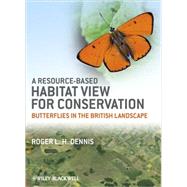
Note: Supplemental materials are not guaranteed with Rental or Used book purchases.
Purchase Benefits
Looking to rent a book? Rent A Resource-Based Habitat View for Conservation Butterflies in the British Landscape [ISBN: 9781405199452] for the semester, quarter, and short term or search our site for other textbooks by Dennis, Roger L. H.. Renting a textbook can save you up to 90% from the cost of buying.
| Foreword | |
| Preface | |
| Acknowledgements | |
| What is a habitat? An awkward question | |
| Definitions of habitat | |
| Distinguishing habitat from biotope and vegetation units | |
| A simple model for butterfly habitats | |
| Habitat model | |
| Key issues in the habitat model | |
| Qualifying resource outlets | |
| Consumables | |
| Utilities | |
| Conditions and conditioners | |
| Resource database | |
| Basic principles for butterfly habitats | |
| Describing variation in resources | |
| Resource variation in the habitat space | |
| Resource dynamics within habitats | |
| Habitats, butterfly resources and population status | |
| Resource dynamics, population status and life cycle strategies | |
| Resources, movements and dispersion patterns inside the habitat | |
| Exploiting individual resources | |
| Patterns and agents in resource use | |
| Some principles relating to single resource use | |
| Distribution of individuals in relation to the distribution of resources | |
| Distribution of individuals on single resource patches | |
| Placement of individual butterflies on single resource items | |
| Manipulation of the micro-landscape: micro-architecture | |
| Foraging: theory and practice | |
| Butterfly habitats: searching for order | |
| Biotope distinctions among British butterflies | |
| Ecological classification of British butterflies | |
| The habitat context for butterfly populations | |
| From populations to metapopulations | |
| Basic principles of metapopulations | |
| The link between structure and dynamics in metapopulations | |
| Empirical studies of butterfly metapopulations in Britain: habitat quality matters | |
| Metapopulations and a resource view of the matrix | |
| From metapopulations to an entire landscape approach | |
| Landscape influences on butterfly habitats | |
| Landscape-scale studies | |
| Landscape components and their influence on butterfly habitat distributions | |
| Influence of landscape and landform elements on butterfly habitats and resources | |
| Case examples of the impact of landscape features on butterfly resources | |
| Translating concepts from the habitat to a landscape scale | |
| Landscape-scale studies on butterflies | |
| Landscape modelling approaches | |
| Habitat issues in butterfly geographical ranges | |
| Components of geographical ranges | |
| Ecological factors underlying ranges and distributions | |
| Range changes before records | |
| Present and future distributions: climate and land use changes | |
| Habitats in butterfly conservation | |
| Approaches to conservation and conserving butterflies | |
| The single site in butterfly conservation | |
| Multiple sites in single and multispecies approaches | |
| Guiding principles for landscape restoration | |
| Butterflies as indicators and flagship species | |
| Appendices | |
| Biodiversity Action Plan (BAP) status, legal protection and taxonomic relationships for British butterflies | |
| Resident and recently extinct species | |
| Rare migrants, introductions and/or long-extinct species | |
| Taxonomic affinities of British butterflies | |
| Larval hostplants for British butterflies | |
| Status of hostplants | |
| Hostplant families, range of butterfly herbivory and hostplant phenology | |
| Larval hostplant biotopes, phenology, growth forms, environments and life history strategies | |
| Nectar sources of British butterflies | |
| Key flowering nectar plants used by butterfly species | |
| Nectar plants supporting 10 or more butterfly species | |
| Nectar plant families supporting six or more butterfly species | |
| Nectar plants used by butterflies more often or less often than expected | |
| Adult feeding: nectar and non-nectar sources | |
| Statistics on larval host use and adult feeding in British butterflies | |
| Utility resources and life history data on British butterflies | |
| Adult environment | |
| Egg environment | |
| Larval environment | |
| Pupal environment | |
| Life history | |
| Adult and larval behaviour in British butterflies | |
| Adult behaviour | |
| Larval behaviour | |
| Biotopes for British butterflies | |
| References | |
| Index | |
| Table of Contents provided by Publisher. All Rights Reserved. |
The New copy of this book will include any supplemental materials advertised. Please check the title of the book to determine if it should include any access cards, study guides, lab manuals, CDs, etc.
The Used, Rental and eBook copies of this book are not guaranteed to include any supplemental materials. Typically, only the book itself is included. This is true even if the title states it includes any access cards, study guides, lab manuals, CDs, etc.